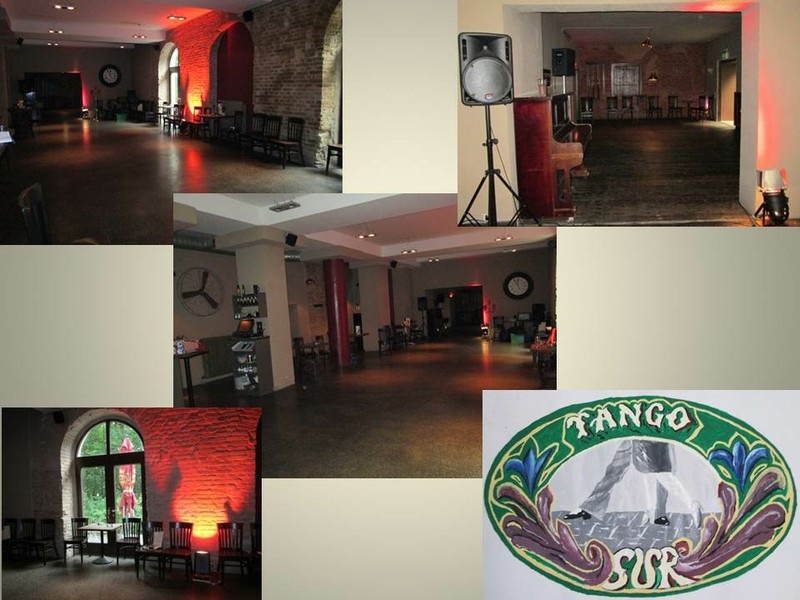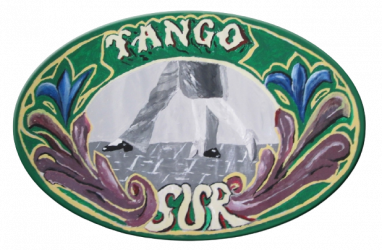Tangodanza 1/2014
Interview mit dem Tangolehrerpaar Natalia Hassan und Leonel Mendieta aus Buenos Aires („Viel unterwegs“) sowie ein Portrait über die Münchnerin Theresa Faus mit dem Titel „Ich mache nur, was mir gefällt!“ http://www.tangodanza.de/product_info.php?products_id=1059&cPath=1
DJ Stefan OK aus Halle
Tangodanza 1/2014
Ein Portrait über die Münchnerin Theresa Faus und ein Interview mit dem argentinischen Tangolehrerpaar Natalia Hassan & Leonel Mendieta
Milonga Tango SUR
Tangodanza 2/2013
Für die Ausgabe 2/2013 habe ich eine CD von Anibal Troilo rezensiert.
Antti Suniala aus Finnland / Berlin
Antti Suniala aus Finnland / Berlin
The Dance Master Classics
Tango 1944-1959
Vom französischen Label Frémeaux stammt die CD Tango 1944-1959 aus ihrer Reihe „Anthologie des Musique de Danse du Monde“. Andere CDs der Reihe widmen sich z.B. dem Wiener Walzer, spanischen Tänzen, Cha Cha Cha, usw. Von den 20 Tangos sind allein sechs von dem hierzulande vielleicht nicht so häufig gespielten ‚Manuel Pizarro et son Grand Orchestre Argentin’ vertreten, allesamt Aufnahmen aus dem Jahr 1959 (Jalousie, Adiós Pampa mía, Como te quiero, La Puñalada, Pelegaria, Tango de reve), die bisher teilweise nur auf Vinyl vorhanden waren. Laut beiliegendem Essay von Teca Calazans & Philippe Lesage war Manuel Pizarro eine führende Persönlichkeit des Pariser Nachtlebens und ist wohl daher so prominent hier vertreten. Weitere in Frankreich bekannte Orchester sind ‚Armandino’ (Cumparsita und Yo no sé por qué te quiero, beide 1957) und ‚Armando Pontier’ (Uno und Margo mit dem Sänger Julio Sosa, beide 1958 und 9 de Julio, 1955). Aus Pontiers Feder stammen Klassiker wie Cada día te extrano más. Die bekannten Tangos sind im orchestralen Stil der 50er Jahre interpretiert.
Von Di Sarli ist nur der Gassenhauer Bahía Blanca (1957) hier vertreten. Aus unterschiedlichen Troilo-Formationen finden sich La Bordona (1955), Sobre el pucho (1953) und Orlando Goni (1959), von Pugliese die allseits bekannten Stücke Mala Pinta (1944) und El Monito (1955).
Bei dieser Anthologie handelt es sich zumeist um argentinische Orchester, die in Paris gespielt haben. Allerdings erwarte ich von einer Anthologie eigentlich eine breitere Streuung von repräsentativen Titeln, und diese sollten dann nicht zu einem knappen Drittel vom gleichen Orchester eingespielt sein. Die CD ist stark 50er-Jahre lastig mit gleich sieben Aufnahmen aus dem Jahr 1959, im Vergleich zu lediglich drei Tangos aus den 40er Jahren. Es bleibt unklar, warum explizit die Jahre 1944-1959 ausgewählt wurden. Wenn es die Absicht war, das ‚Goldene Zeitalter‘ des Tango abzudecken, dann deckt sich das nicht ganz mit der ausgewählten Periode. Leider liegen das Essay und weitere Infos im Beiheft nicht auf Deutsch vor, sondern nur in französischer Sprache mit einer kurzen Zusammenfassung auf Englisch. Auch die Rechtschreibfehler fallen leider negativ auf.
Der orchestrale Sound gibt Stücken wie Uno, La Cumparsita, Puñalada, 9 de Julio, Yo no sé por qué te quiero einen schönen weichen Anstrich. Wem noch Aufnahmen aus den 1950er-Jahren und/oder Pizarro, Pontier und Armandino in der Sammlung fehlen, für den ist die Anschaffung dieser CD durchaus sinnvoll.
Susanne Mühlhaus (Rezension in Tangodanza 2-2012)
siehe auch: http://www.tangodanza.de/product_info.php/products_id/936/cPath/4/cds/dance-master-classics-1944-1959.html
Tuesday, May 15. 2012
Trío Central – No False Alert!
First of all: „Falsa Alarma“ („False Alert“) by Trio Central is simply brillliant and one can only wish for such a false alarm! My favourite pieces are „El Pollo Ricardo“ and „Boedo“ – the wonderfully playful piano is just ingenious here as well as the replying bandoneon. Or perhaps all of the songs are my favourite pieces?
The piano is cheekily providing the tune for the bandoneon in „Organito de la Tarde“. The interplay of these two instruments is breathing fresh, new life to the the Di Sarli classic „Bahía Blanca“ which we have been listening to almost too many times. But, hey we would love to listen to it again now in this fresh interpretation by Trío Central. Very convincing is the title piece „Falsa Alarma“, composed by the pianist Pablo Woizinski. The bandoneon playerChristian Gerber is also a member of the successful Quinteto Angel. What instrument does the third musician of Trío Cntral play again? Oh, well, contrabass. Well, since Patrick Süsskind’s eponymous novel the destiny of double bass players has been well-known. One only perceives them marginally, but honestly, Rodolfo Paccapelo’s contrabass would seriously go amiss as a structural frame and as a strong background sound. Eventually, in „Tango Apasionado – Finale“ the contrabass player has his moments of fame. A feast to your ears, and my legs can’t keep quiet either on listening to „la Retirada“, written by Juan Carlos Cáceres. This CD contains even two versions of this piece. The piano can almost cope with this piece on its own when I perceive the contrabass in the background and only after a good third of the piece is over, the bandoneon comes in and give „Retirada“ a whole noe drive.
And really, we can’t say that we are missing a single further instrument here with this Trio. Trío Central provides fully-fledged Tango delicatessen and the pieces are almost all superbly danceable. A great debut CD by this formation of three young musicians from Buenos Aires and Berlin, that doesn’t leave any wishes unfulfilled. Oh, there would be one though! I would really love them to come to Munich and perform live at my milonga, one of these days. Well, until then I can happily while away the time by listening to their CD…
Friday, April 20. 2012
Ensemble Libertango – El Porteño – Suitably Framed by Piazzolla’s Four Seasons in Buenos Aires
 The very first piece makes me wander off into the land of daydreaming. „Prepárense“ – „Prepare Yourselves!“ is the appropriate title of the first Tango by Astor Piazzolla on this CD by the Ensemble Libertango. And so I am preparing myself for further auditory pleasure which this CD promises. Piazzolla provided nine further compositions to this CD. The perfect chill-out music accompanying a longdrink or cocktail at sunset – and letting the day’s events pass review again before I eventually leave it all behind and allow myself to indulge in the freely floating associations that this music evokes. During spring in Buenos Aires („Primavera Porteña“) I see the lush blue-violet coloured blossoms of the jacaranda trees, perfect beauty beyond comparison.
The very first piece makes me wander off into the land of daydreaming. „Prepárense“ – „Prepare Yourselves!“ is the appropriate title of the first Tango by Astor Piazzolla on this CD by the Ensemble Libertango. And so I am preparing myself for further auditory pleasure which this CD promises. Piazzolla provided nine further compositions to this CD. The perfect chill-out music accompanying a longdrink or cocktail at sunset – and letting the day’s events pass review again before I eventually leave it all behind and allow myself to indulge in the freely floating associations that this music evokes. During spring in Buenos Aires („Primavera Porteña“) I see the lush blue-violet coloured blossoms of the jacaranda trees, perfect beauty beyond comparison.Piazzollas Four Seasons in Buenos Aires provide the framework for this CD, with further pieces harmoniously arranged within this structure. But I admit, I am understating things here! Listening to this CD again, I consider the structure no less than brilliant! „El aeroplano“ by Roberto Firpo magics the mild spring evening breeze onto my cheeks – I am actually able to say this right now because I am writing this in spring time and in the evening too! Via „Triunfal“ by Piazzolla we continue the journey to the summer in Buenos Aires („Verano Porteño“). What joy! And I can already feel the sweat running down my temples because I cannot remain on my seat when listening to the summer Tangos and valsecitos. Rarely have I enjoyed a more vivid interpretation of „Bordoneo y 900“. I find myself sitting in a theatre – is it the Teatro Cervantes in Buenos Aires? – and barely half into this piece I cannot resist jumping up from my seat and wanting to applaud the orquestra. „Desde el alma“ does not get me back onto my seat but instead I start dancing, oblivious to my surroundings.
Following the subsiding autumn gales of the „Otoño Porteño“ I contemplate Piazzolla’s „Ballad for an Insane“ and I find myself levitating into the night carried by the question and answer game of „Nocturna“. „Lágrimas y sonrisas“ is so wonderfully danceable in this smooth interpretation by the Ensemble Libertango, peaking in a fulminant ending. I immerse myself further in the autumn, accopanied by the sensitive approach and, by the same token, so intense interpretation of „Nostalgias“, where the various instruments seem to bring to the fore contradictory thoughts and feelings and at the right time unite them all back to harmony.
Winter in Buenos Aires („Invierno Porteño“) first makes me slide into melancholy and then instils me with newly found confidence and I really think that it is a successful transition to „Libertango“. Here, the piano evokes the sound of the falling winter rain which is then replaced by the supporting bow instruments. This is followed by the accordion intervening and all together they eagerly advance to the grand finale. I just love this piece!
Immediately I listen to „El Porteño“ once again and I discover more magic… Unbelievable!
This CD will definedly accompany me on my next flight to Buenos Aires. At the moment, I can hardly image a more enjoyable transition from Europe to Argentina. “.
Orquesta Típica Misteriosa Buenos Aires – Tango De Salón – Great Debut CD
Orquesta Típica Misteriosa Buenos Aires – Tango de Salón
3 bandoneons, 3 violins, a contrabass, a piano and 2 singers: This young orchestra of ten musicians have set their sights on following the lead of
Carlos di Sarli, that is to play pieces melodically, in a steady and therefore danceable rhythm and with a romantic touch. And it is exactly that what they have achieved with this CD!
Fresh interpretations of popular Tangos like „9 de Julio“ in a slower version, which provides room for a playful piano tune. I listen eagerly to the fresh tunes of „En esta Tarde Gris“, „Loca“, „Recuerdo“ and „Nostalgias“.
Thanks to the voices of Marisol Martínez and Marcelo Rey traditional Tangos such as „En esta tarde gris“ (Rey) get a contemporary flair. Martínez‘ voice lets us see the rising mist above the river Riachuelo. slowly meandering its way at the southern rims of the City of Buenos Aires. And we believe Marcelo Rey that he wants to get inebriated in the face of a hopelessly lost love (Nostalgias). The first few lines are particularly catchy „Quiero emborrachar mi corazón, para apagar un loco amor, que más que amor es un sufrir…“ („I want to drown my heart to extinguish a crazy love that is more suffering than love…“).
Javier Arias is the musical head of this formation. 4 members of his former enseble Orquesta Típica Fervor de Buenos Aires are part of the Orquesta Típica Misteriosa Buenos Aires.
My personal favourites of this CD are „9 de Julio“, „Recuerdo“, „Nostalgias“, „Felicia“ and „Perdóname“. Of the 14 pieces 8 are instrumental versions; there are 13 tangos and 1 milonga. And there are also 2 folklore pieces as bonus tracks (Chacarera and Gato).
This thoroughly danceable debut CD recorded by this orchestra will not only enrich the music library of all tango dancers and Tango DJs but it also whets everyone’s appetite for further recordings by the Orquesta Típica Misteriosa Buenos Aires.
You can also see and listen to this orchestra live in Buenos Aires since they play, as the house orquestra, at the Milonga „La Misteriosa“ in Humberto Primo 2758, every Wednesday.
The Orquesta Típica Misteriosa Buenos Aires live.
Susanne Mühlhaus
http://www.danzaymovimiento.com/dymlog/
Tango Sur München – Su Tango München
 ERÖFFNUNG von TANGO SUR,
ERÖFFNUNG von TANGO SUR,
die neue traditionelle Sonntagsmilonga im Ellington – im ehemaligen Kaffee Giesing von Konstantin Wecker.
Tangotanzfest jede Woche sonntags ab 18. August!
Tango tanzen auf Steinboden und Fichtenparkett auf ca. 150 qm. Direkter Zugang zur Terrasse, wo man am lauen Sonntagabend noch schön draußen sitzen kann. Wenn es drinnen zu warm wird, schalten wir einfach die Lüftung ein!
DJ bei der Eröffnungsmilonga: Theresa Faus, danach wechselnde DJs
Musik: traditionell mit Tandas und Cortinas
Milonga:19:30-23:30h
Eintritt €7
Bei TANGO SUR im Ellington könnt Ihr auch die Zeitschrift TANGODANZA erwerben.
Offener Unterricht von 18-19:30h, Preis €20 inkl. Eintritt zur Milonga. Noch günstiger mit 5-er Karte (€90 für 5×1,5h Unterricht & 5x Milongabesuch am selben Tag)
Ellington, Bergstr. 5, 81539 München-Giesing – Haltestellen in der Nähe: Silberhornstr. U2 & Tram & Busse, Candidpl. U1
Tango im INTERIM: Im August & September ist Sommerpause im Interim.
Das Interim war eine Interimskirche, erbaut zu Anfang des 20. Jahrhunderts, weil man für Arbeiter, die in München-Laim angesiedelt wurden, auch eine seelsorgerische Heimat brauchte. Als später eine größere Kirche in der Nachbarschaft errichtet wurde, sollte diese Interimskirche abgerissen werden. Der Abbruch konnte aber durch die unermüdlichen Bemühungen einer lokalen Bürgerinitiative verhindert werden und so ist aus der ehemaligen Interimskirche heute das Kulturzentrum Bürgertreff Interim e.V. geworden. Für den Münchener Stadtteil Laim ist das Interim ein lebendiger kultureller Fokus – und das nun schon seit vielen Jahren. Die Atmosphäre im Interim passt wirklich gut zum Tango-Ambiente. Das Interim erinnert mich ein wenig an die Milonga-Location „La Catedral“ in Buenos Aires, einem ehemaligen Kornspeicher. Auch das Interim hat ein Gewölbedach und daher eine sehr gute Akustik. Der Holzdielenboden im Interim stammt aus dem Baujahr, also gewissermaßen aus der Entstehungszeit des Tango, und auf dünnen Bleistiftabsätzen sollten die Tangueras einen guten Stand haben.
Im Interim geben wir 1x im Monat von 19:30-21h offenen Tangounterricht in TANGO BASICS – geeignet für alle Niveaus vom Anfänger über Mittelstufe bis zum fortgeschrittenen Tänzer. Wir unterichten unterschiedliche Schwierigkeitsgrade und wechselnde Themen. Viele fortgeschrittene Tänzer wollen zurück zu den BASICS, denn die Basics sind am schwierigsten. Da steckt so viel drin. Manchmal greifen wir auch ein Thema nochmals auf, um es auf Wunsch der Teilnehmer weiter zu vertiefen oder breiter zu behandeln. Typische Unterrichtsthemen könnt ihr hier sehen.



